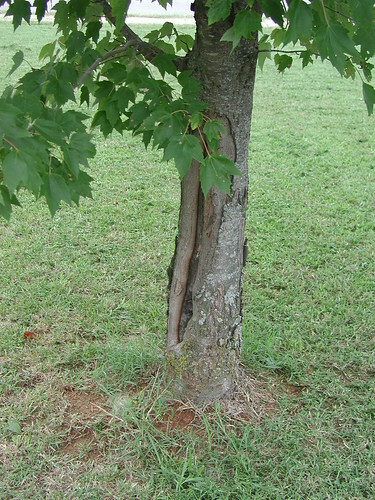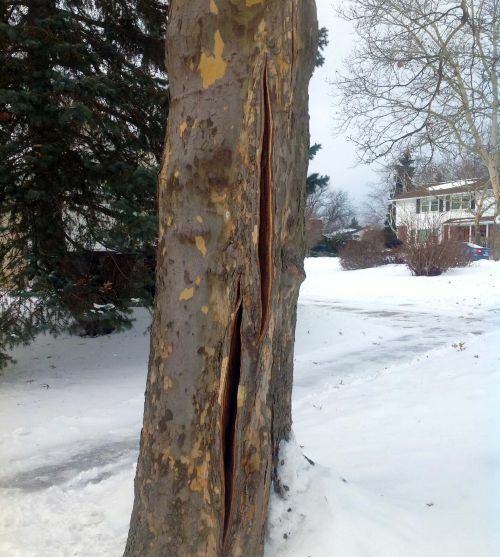Bark damage on young trees is like a wound on your skin. It makes the tree more vulnerable to disease infections, pests, and other types of stress. And just like people, younger trees have thinner and more delicate bark, making them more susceptible to damage. However, they are also better able to bounce back if taken care of properly. Check out these tips and info to help you save a young tree with damaged bark.
Common Causes of Bark Damage in Young Trees
Understanding what caused the bark damage in the first place helps you solve the problem and prevent it. Here are some common causes:
- Physical Impact: Lawn mowers, weed trimmers, and gardening tools often accidentally wound trees.
- Animal Damage: Deer rubbing their antlers, squirrels chewing, or other wildlife can strip bark from young trees.
- Sunscald: Intense sunlight during winter can cause the bark to crack and peel, especially on the south and southwest sides of the trunk.
- Frost Cracking: Rapid temperature changes can lead to bark splitting in cold climates.
- Pest Infestation: Insects like borers can damage bark as they tunnel into the tree.
- Diseases: Certain fungal and bacterial infections can weaken the bark.

Sun Scald

Frost Cracking Bark
Assessing the Extent of Bark Damage
Before jumping into repairs, assess the severity of bark damage to see if recovery is possible.
- Inspect the Wound: Examine the size and location of the damaged area. Is the bark peeled off entirely or just scratched?
- Check for Girdling: If the damage encircles more than 50% of the trunk, the tree’s ability to transport water and nutrients might be severely compromised.
- Look for Signs of Infection: Discolored sap, a foul smell, or fungal growth are clues that the wound has become infected.
- Evaluate Overall Health: A healthy tree with robust foliage and no signs of decline is more likely to recover than one that is already stressed.
Repairing Tree Bark Damage
Minor bark damage can be treated with these methods:
Clean the Wound
Use a clean, sharp knife to remove any loose or jagged bark around the wound. Avoid cutting into healthy tissue. The goal is to create smooth edges that promote healing.
Perform Bark Tracing
Bark tracing involves carefully cutting the edges of the wound into an oval or elongated shape. Make shallow cuts just outside the wound’s edge to outline it. This technique prevents further peeling and encourages the tree to grow new tissue over the damaged area.

Protect the Wound
Do not apply wound paints or sealants, as they can trap moisture and promote disease. Instead, allow the tree to heal naturally. If the tree is in a high-risk area for pests or infections, consult an arborist about suitable protective measures.
Provide Extra Care
Provide some extra TLC to help the tree recover:
- Water the tree as needed, especially during dry spells.
- Apply a balanced fertilizer to support growth.
- Mulch around the base of the tree to retain soil moisture and regulate temperature, but keep mulch away from the trunk to avoid rot.
Will My Tree Recover From Damaged Tree Bark?
Whether or not your tree recovers depends on the extent of the damage, the tree’s overall health, and the care it receives. Here are some things to keep in mind:
- Healthy Trees Recover Faster: A tree that is well-watered, fertilized, and pest-free has a better chance of healing.
- Extent of Damage Matters: If less than 25% of the bark is affected, the tree is likely to recover with proper care. Damage covering 50% or more of the circumference might be fatal.
And keep in ming that if the tree is severely girdled or shows signs of decline despite your efforts, removal might be the safest option to prevent hazards and damages to property.
Does Tree Bark Grow Back?
Unlike human skin, tree bark doesn’t regenerate in the same way. Instead, trees form a protective layer called callus tissue over the wound. Over time, this tissue will harden and become part of the tree’s outer surface, sealing the damaged area.
- Healing Timeline: Small wounds may heal within a year, while larger ones can take several years to close completely.
- Structural Integrity: Although the wound might seal, the affected area may remain weaker than the rest of the trunk. Monitor the tree for signs of stress or cracking in the future.
Preventing Future Bark Damage
Prevention is always better than repair. Here are some tips to protect your young trees:
- Use Mulch: Spread a 2-4 inch layer of mulch around the base of the tree, extending to the drip line. This not only retains moisture but also creates a barrier to protect the trunk from lawn equipment.
- Install Tree Guards: Wrap tree guards or protective tubing around the trunk to shield it from animal damage and mechanical injuries.
- Anchor the Tree: If the tree bark is being damaged by lack of overall tree stability or high winds, install tree anchoring to prevent further bark wounds. Newly planted trees often benefit from extra support while their roots establish into the soil.
- Prune Carefully: Avoid excessive pruning, as it can expose the tree to sunscald and pests.
- Tree Health Care: Provide the tree with proper watering, fertilizing, and pest treatments to help maintain overall health, which will make the tree more resistant to bark damage.
When to Seek Professional Help
Contact a professional arborist for help if you notice any of the following:
- Severe Girdling: If the damage encircles most of the trunk, get a professional tree assessment.
- Infections or Pests: Signs of disease or infestation require expert treatment to prevent further spread.
- Hazardous Trees: If the tree is leaning, has structural weaknesses, or poses a safety risk, removal might be the best option.
Our A Plus Tree team of arborists have the tools and knowledge to evaluate bark wounds, repair them, and help prevent future damage. If tree removal ends up being necessary, we can perform it safely and efficiently. Whatever your tree concerns are, don’t hesitate to reach out to us!





